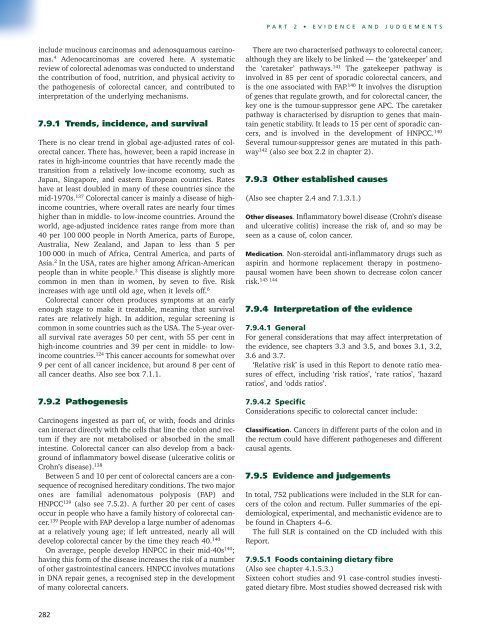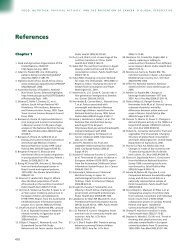Full Report - Food, Nutrition, and the Prevention of Cancer
Full Report - Food, Nutrition, and the Prevention of Cancer
Full Report - Food, Nutrition, and the Prevention of Cancer
Create successful ePaper yourself
Turn your PDF publications into a flip-book with our unique Google optimized e-Paper software.
include mucinous carcinomas <strong>and</strong> adenosquamous carcinomas.<br />
4 Adenocarcinomas are covered here. A systematic<br />
review <strong>of</strong> colorectal adenomas was conducted to underst<strong>and</strong><br />
<strong>the</strong> contribution <strong>of</strong> food, nutrition, <strong>and</strong> physical activity to<br />
<strong>the</strong> pathogenesis <strong>of</strong> colorectal cancer, <strong>and</strong> contributed to<br />
interpretation <strong>of</strong> <strong>the</strong> underlying mechanisms.<br />
7.9.1 Trends, incidence, <strong>and</strong> survival<br />
There is no clear trend in global age-adjusted rates <strong>of</strong> colorectal<br />
cancer. There has, however, been a rapid increase in<br />
rates in high-income countries that have recently made <strong>the</strong><br />
transition from a relatively low-income economy, such as<br />
Japan, Singapore, <strong>and</strong> eastern European countries. Rates<br />
have at least doubled in many <strong>of</strong> <strong>the</strong>se countries since <strong>the</strong><br />
mid-1970s. 137 Colorectal cancer is mainly a disease <strong>of</strong> highincome<br />
countries, where overall rates are nearly four times<br />
higher than in middle- to low-income countries. Around <strong>the</strong><br />
world, age-adjusted incidence rates range from more than<br />
40 per 100 000 people in North America, parts <strong>of</strong> Europe,<br />
Australia, New Zeal<strong>and</strong>, <strong>and</strong> Japan to less than 5 per<br />
100 000 in much <strong>of</strong> Africa, Central America, <strong>and</strong> parts <strong>of</strong><br />
Asia. 2 In <strong>the</strong> USA, rates are higher among African-American<br />
people than in white people. 3 This disease is slightly more<br />
common in men than in women, by seven to five. Risk<br />
increases with age until old age, when it levels <strong>of</strong>f. 6<br />
Colorectal cancer <strong>of</strong>ten produces symptoms at an early<br />
enough stage to make it treatable, meaning that survival<br />
rates are relatively high. In addition, regular screening is<br />
common in some countries such as <strong>the</strong> USA. The 5-year overall<br />
survival rate averages 50 per cent, with 55 per cent in<br />
high-income countries <strong>and</strong> 39 per cent in middle- to lowincome<br />
countries. 124 This cancer accounts for somewhat over<br />
9 per cent <strong>of</strong> all cancer incidence, but around 8 per cent <strong>of</strong><br />
all cancer deaths. Also see box 7.1.1.<br />
7.9.2 Pathogenesis<br />
Carcinogens ingested as part <strong>of</strong>, or with, foods <strong>and</strong> drinks<br />
can interact directly with <strong>the</strong> cells that line <strong>the</strong> colon <strong>and</strong> rectum<br />
if <strong>the</strong>y are not metabolised or absorbed in <strong>the</strong> small<br />
intestine. Colorectal cancer can also develop from a background<br />
<strong>of</strong> inflammatory bowel disease (ulcerative colitis or<br />
Crohn’s disease). 138<br />
Between 5 <strong>and</strong> 10 per cent <strong>of</strong> colorectal cancers are a consequence<br />
<strong>of</strong> recognised hereditary conditions. The two major<br />
ones are familial adenomatous polyposis (FAP) <strong>and</strong><br />
HNPCC 139 (also see 7.5.2). A fur<strong>the</strong>r 20 per cent <strong>of</strong> cases<br />
occur in people who have a family history <strong>of</strong> colorectal cancer.<br />
139 People with FAP develop a large number <strong>of</strong> adenomas<br />
at a relatively young age; if left untreated, nearly all will<br />
develop colorectal cancer by <strong>the</strong> time <strong>the</strong>y reach 40. 140<br />
On average, people develop HNPCC in <strong>the</strong>ir mid-40s 140 ;<br />
having this form <strong>of</strong> <strong>the</strong> disease increases <strong>the</strong> risk <strong>of</strong> a number<br />
<strong>of</strong> o<strong>the</strong>r gastrointestinal cancers. HNPCC involves mutations<br />
in DNA repair genes, a recognised step in <strong>the</strong> development<br />
<strong>of</strong> many colorectal cancers.<br />
282<br />
P ART 2 • EVIDENCE AND JUDGEMENTS<br />
There are two characterised pathways to colorectal cancer,<br />
although <strong>the</strong>y are likely to be linked — <strong>the</strong> ‘gatekeeper’ <strong>and</strong><br />
<strong>the</strong> ‘caretaker’ pathways. 141 The gatekeeper pathway is<br />
involved in 85 per cent <strong>of</strong> sporadic colorectal cancers, <strong>and</strong><br />
is <strong>the</strong> one associated with FAP. 140 It involves <strong>the</strong> disruption<br />
<strong>of</strong> genes that regulate growth, <strong>and</strong> for colorectal cancer, <strong>the</strong><br />
key one is <strong>the</strong> tumour-suppressor gene APC. The caretaker<br />
pathway is characterised by disruption to genes that maintain<br />
genetic stability. It leads to 15 per cent <strong>of</strong> sporadic cancers,<br />
<strong>and</strong> is involved in <strong>the</strong> development <strong>of</strong> HNPCC. 140<br />
Several tumour-suppressor genes are mutated in this pathway<br />
142 (also see box 2.2 in chapter 2).<br />
7.9.3 O<strong>the</strong>r established causes<br />
(Also see chapter 2.4 <strong>and</strong> 7.1.3.1.)<br />
O<strong>the</strong>r diseases. Inflammatory bowel disease (Crohn’s disease<br />
<strong>and</strong> ulcerative colitis) increase <strong>the</strong> risk <strong>of</strong>, <strong>and</strong> so may be<br />
seen as a cause <strong>of</strong>, colon cancer.<br />
Medication. Non-steroidal anti-inflammatory drugs such as<br />
aspirin <strong>and</strong> hormone replacement <strong>the</strong>rapy in postmenopausal<br />
women have been shown to decrease colon cancer<br />
143 144 risk.<br />
7.9.4 Interpretation <strong>of</strong> <strong>the</strong> evidence<br />
7.9.4.1 General<br />
For general considerations that may affect interpretation <strong>of</strong><br />
<strong>the</strong> evidence, see chapters 3.3 <strong>and</strong> 3.5, <strong>and</strong> boxes 3.1, 3.2,<br />
3.6 <strong>and</strong> 3.7.<br />
‘Relative risk’ is used in this <strong>Report</strong> to denote ratio measures<br />
<strong>of</strong> effect, including ‘risk ratios’, ‘rate ratios’, ‘hazard<br />
ratios’, <strong>and</strong> ‘odds ratios’.<br />
7.9.4.2 Specific<br />
Considerations specific to colorectal cancer include:<br />
Classification. <strong>Cancer</strong>s in different parts <strong>of</strong> <strong>the</strong> colon <strong>and</strong> in<br />
<strong>the</strong> rectum could have different pathogeneses <strong>and</strong> different<br />
causal agents.<br />
7.9.5 Evidence <strong>and</strong> judgements<br />
In total, 752 publications were included in <strong>the</strong> SLR for cancers<br />
<strong>of</strong> <strong>the</strong> colon <strong>and</strong> rectum. <strong>Full</strong>er summaries <strong>of</strong> <strong>the</strong> epidemiological,<br />
experimental, <strong>and</strong> mechanistic evidence are to<br />
be found in Chapters 4–6.<br />
The full SLR is contained on <strong>the</strong> CD included with this<br />
<strong>Report</strong>.<br />
7.9.5.1 <strong>Food</strong>s containing dietary fibre<br />
(Also see chapter 4.1.5.3.)<br />
Sixteen cohort studies <strong>and</strong> 91 case-control studies investigated<br />
dietary fibre. Most studies showed decreased risk with



